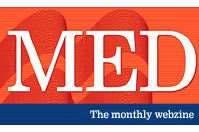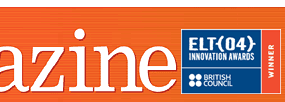 |
 |
 |
 |
 |
 |
|
|
|||
|
COLUMNS
|
Last in the series of articles on metaphor
A dictionary is far more than just a list of words in the language with their definitions and details of their accompanying grammatical behaviour. It is a vast repository of information about the culture and attitudes in the countries where that language is spoken. It is a snapshot of the way we see things and feel about things, of the images and metaphors which we use, consciously or unconsciously, when we talk about any subject in our lives. Examining and understanding, en masse, the body of vocabulary and phrases which relates to any given subject is a useful way to discover the ideas and attitudes embedded in the words we use. It is also an interesting and efficient way to expand and enrich one's vocabulary. Unlike idioms, which generally allow very little freedom for variation or invention, metaphors can be adapted, built upon and played with, so long as the central idea remains intact. Once we have grasped the core ideas relating to a topic in English, we can start to use these to create our own metaphors using synonyms to make our language more fluent, inventive, poetic, or even amusing. These novel uses may even catch on and find their way into future editions of the dictionary. This month we look at honesty and dishonesty. What do we talk about when we talk about honesty and dishonesty? Honesty is white and clean; dishonesty is dark and dirty Candid, which is defined in the dictionary as 'honest and direct, even when the truth is not pleasant', came into English via French from the Latin word candidum, meaning 'white', which came from the verb candere 'to be white, to glow'. This same source word, which, through metaphorical sense extension, eventually changed its meaning from 'white' to honest also gave us candle and incandescent, thus showing the link between the ideas of whiteness and light and our notions of truth. The adjective white also has at its roots this link with light, since it comes from the same Indo-European word kwitnos or kwidnos that gave rise to the Russian word for light — svet. When we consider someone or something 'completely fair and honest', we say that it is white, lily-white, or whiter than white, thus emphasising an absence of blemishes or stains that is seen in many words we use to describe honest people and behaviour. An honest person is squeaky clean, stainless, or as clean as a whistle. The adjective sincere, meaning 'true and honest', comes from Latin sincerus, meaning 'clean and pure'. When somebody tells the truth they make a clean breast of it or come clean. If you try to live an honest life, you keep your nose clean. Dishonest people and behaviour, on the other hand, are shady, dirty, grubby, down-and-dirty, sleazy, slick, or slippery. Dishonest methods for achieving things are humorously referred to as the black arts or labelled dirty tricks. If you get involved in dishonest dealings, you get your hands dirty or play dirty. Dishonesty is dark and dirty. Honesty is straight; dishonesty is crooked Honesty exists in our minds and language along a straight line. An honest person is direct, on the level, straight, straight talking, as straight as a die, straightforward, or straight up. Somebody who decides to live an honest life resolves to go straight and to live on the straight and narrow. Even the word true has a, mainly technical, meaning that is defined as 'completely straight, upright, or level'. Dishonesty is quite the opposite. The dishonest person is bent, crooked, or devious. The word devious comes from Latin deviare which is formed by combining the prefix de-, meaning 'from' and the noun via, meaning 'way'. Thus, devious means, literally, 'departing from the way', reflecting the idea of straying from the straight path (the straight and narrow) often found in biblical imagery. If someone tries to deceive someone, they bend the truth, distort the truth (from Latin distorquere, meaning 'to twist completely') or lead somebody astray. Honesty is up; dishonesty is down Like most things that are seen as universally good (e.g. success (as discussed in Issue 16), and good health (as discussed in Issue 15)), honesty exists metaphorically on a high plane. An honest person is described as being on the up and up, upright, upfront, or upstanding. If we want to emphasize that something we are saying is true, the informal interjection is straight up. Honest dealings are described as above board. At the other extreme we have the dishonest person or dishonest activities being described as low, the lowest of the low, lowdown, underhand or underhanded, or underground. If somebody does something very unfair or dishonest, we ask how they could stoop/sink so low. Honesty is bare and open; dishonesty is covered and closed An honest person is open — 'used about someone who is honest and does not keep things secret' — and openness is 'an honest way of talking'. Related to this idea of clarity and visibility, is transparency — 'an honest way of doing things that allows other people to know exactly what you are doing'. We also talk about the naked truth. Conversely, when we look at the way we talk about lies and lying, we find an underlying theme of hiddenness and obscured visibility, of obscurantism — '... so that people do not know the truth'. The liar tries to cover up the truth with metaphorical cloth which he/she often weaves like a spider. The liar spins somebody a yarn, or embroiders the truth with false details, producing a tissue of lies, or a web of lies. Lies are also described as flannel; another cloth image. The purpose of all this spinning and weaving is to blind somebody to something, or to pull the wool over somebody's eyes. False stories are cover stories, and deception is described as taking place backstairs or at the backdoor rather than out in the open where the truth is laid bare. The verb to hoodwink originally meant 'to make somebody unable to see by covering their eyes with a hood', but soon (in the 17th century) came to have the metaphorical meaning 'to make someone believe something that is not true'. Honesty and dishonesty are treated in our language as opposites which exist at two metaphorical extremes, between which there is nothing. With the possible exception of the half-truth and the white lie when we talk about honesty and dishonesty, there is only truth and lies: whiteness and cleanness versus darkness and dirtiness; straightness versus crookedness; up versus down; openness versus hiddenness. The metaphors and expressions listed above are all taken from the Macmillan English Dictionary and are not intended as a comprehensive list. We would be pleased to hear from any reader who can suggest any other honesty and dishonesty metaphors in English which are not covered here. The Language of Metaphors, Andrew Goatly (Routledge,
1997) For a list of articles published in the series on metaphor, please go to the Index page. |
||
|
|
|||